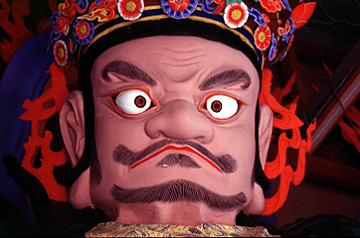
| A monk at Yonghwasa temple on Miruk Island in South Kyongnam Province. | 
|
 |
..the five-tier sari pagoda for Yonghwasa temple's former abbot, Hyogong, who died in the 1980's. |
| This is a stone guardian totem known as a 'poksu', or 'sokjangsung'. It was made in 1906 to ward off evil spirits and disease from the village it protects near Chungmu, in South Kyongsan. In Korea, totems like this are generally made of wood, but in the area of Chungmu and Miruk Island they are made of stone. | 
|
 |
This is Unju-sa, a unique temple in South Cholla Province. Unju-sa has many unusual pagodas and Buddha figures. At one time, the temple was said to have thousands of these stone sculptures. According to 'Pungsu' (otherwise known as 'geomancy', or 'Feng Shui'), the Korean peninsula is unbalanced by the powerful 'Ki' (energy) of the mountains along the East Coast. These stone sculptures made in the southwestern part of the peninsula were an attempt to counterbalance the 'Ki' in the east. |
| The face of a temple guardian statue. Made of wood or clay, one can find these statues at most entrances to Buddhist temples in Korea. | 
|